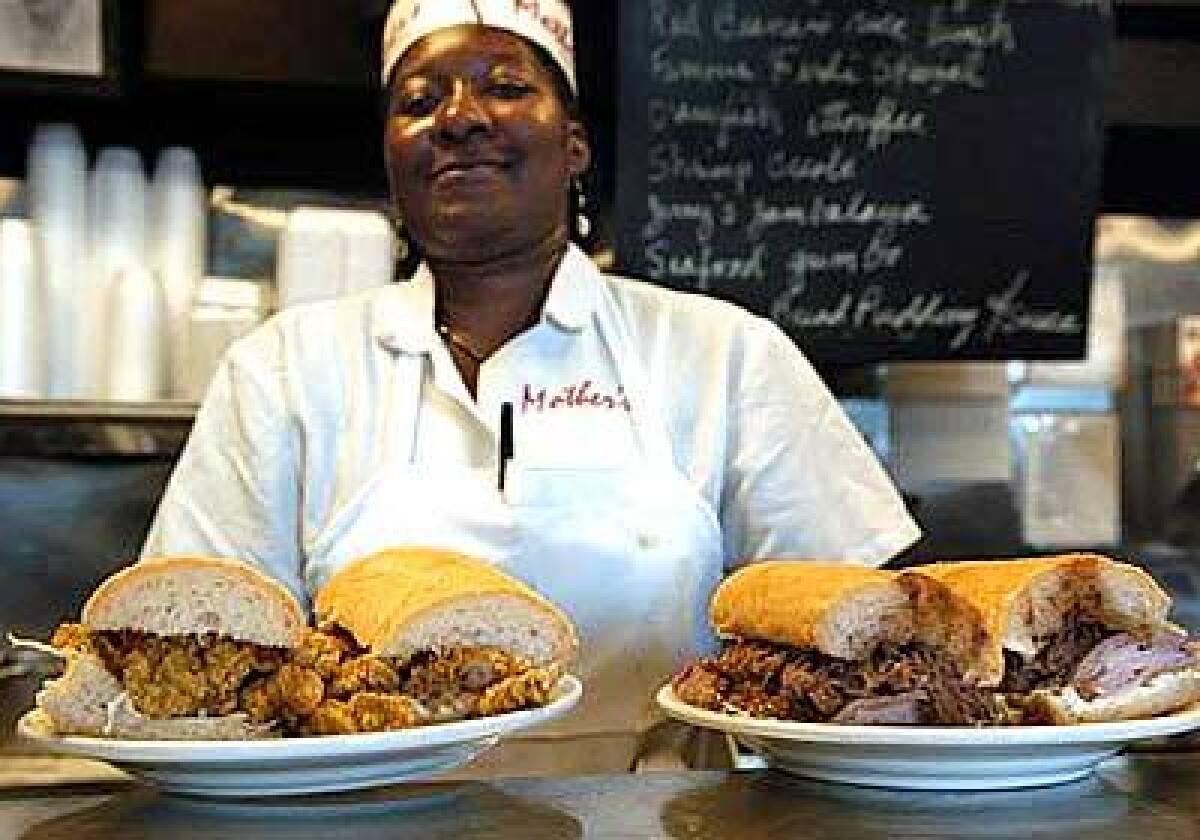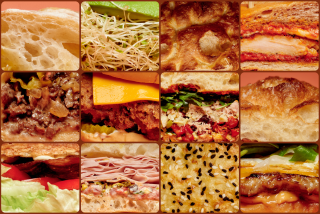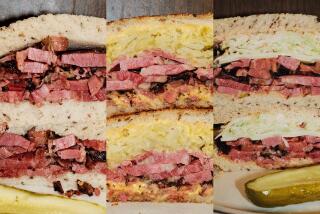Po’ boy bliss in New Orleans

GO to New Orleans without trying the po’ boy? One might as well visit Paris without tasting a fresh baguette. Or tour Athens without sipping ouzo.
A po’ boy, for the uninitiated, is a massive sandwich on French bread crammed with roast beef, ham, shrimp, oysters, meatballs, sausage or even French fries. It’s unlike any hoagie, grinder or submarine sandwich you’ve ever had.
Some say the bread is the secret ingredient. G.H. Leidenheimer Baking Co., New Orleans’ best-known bread supplier, daily sells about 50,000 loaves of their light, crisp-crusted French bread to po’ boy proprietors. A standard 32-inch loaf, which has a distinctive alligator-skin pattern on the crust, can be cut into three or four sandwiches. The bakery makes as many as four deliveries a day to some customers, in vans emblazoned with the slogan “Sink ya teeth into a piece of New Orleans cultcha — a Leidenheimer po-boy!”
The po’ boy legend — like so many Southern legends — begins with two brothers, Bennie and Clovis Martin, bakers and former streetcar drivers. In 1929, during a months-long streetcar strike in New Orleans, they handed out free sandwiches made from leftovers to the striking drivers. As one would approach their restaurant near the French Market, one brother would yell to the other, “Here comes another poor boy.” The name stuck and the sandwiches, which later cost 10 cents apiece, became so popular that carhops would carry orders to customers parked blocks away when the restaurant’s lot overflowed.
In the 75 years since its invention, the po’ boy has inspired many inventive variations — and strong opinions. When I came to New Orleans with my family in May, I set out to find the best. But I didn’t want to leave anything to chance. I consulted reviews, surveys and guidebooks before arriving. Then I asked the top po’ boy makers to weigh in on their competitors.
I also just asked around. During our first taxi ride, I explained my mission to our cabby, Tony, who quickly rattled off 20 of his favorite po’ boy joints. But I persisted: Which one is the best?
“Ain’t no best,” Tony said. “They all good.”
I’d have to agree. But, adjusting for bias, here are the po’ boys that the experts — myself included — agree are even better than good.
Domilise’s
A temple to food, this New Orleans institution serves several award-winning po’ boys. The line goes out the door and into the street; inside, it hugs the sandwich counter, following a path worn deep into the tile floor. Take a number, scan the menu on the wall, place your order and maneuver your way to the bar for a drink — maybe a Barq’s root beer or an Abita lager.At lunchtime, there are five perpetually filled tables and wall-to-wall “to go” customers mingling in the aisles. My wife, Nancy, and I sat at the bar with our 3-year-old daughter, Hannah. Nobody seemed to mind. When you’re finished eating, one of the five women at the counter will add up your tab longhand on a scrap of paper.
On the advice of a food guide, I ordered the off-menu po’ boy with fried shrimp, Swiss and roast beef gravy, which turned out to be my favorite of the trip. The delicate, lightly breaded shrimp occasionally popped out of the sandwich, but none went to waste. The mix of tastes — shrimp, gravy and hot sauce — proved unexpectedly delicious. When I ran out of napkins, I licked my fingers. It’s that kind of place.
Domilise’s was also the farthest off the beaten tourist path — a 15-minute hike from the St. Charles streetcar line. The neighborhood goes from upscale to dicey in a few blocks, so a rental car might be the best transit option. The trip is worth it.
Mother’s
This restaurant churns out 100,000 pounds a year of its claim to fame — black ham with crisp, caramelized crust. The Famous Ferdi Special, Mother’s most popular sandwich, is named for customer Ferdi Stern, who asked for a little ham on his roast beef po’ boy. The Ralph is a Ferdi with cheese, and the John G piles on turkey too, making for a monster. All traditional po’ boys come “dressed,” New Orleans-speak for all the fixins — shredded cabbage, pickles, mayonnaise, Creole and yellow mustard. Tomatoes are frowned upon.We ordered our po’ boys to go. Back at the hotel, I gleefully assembled my roast beef po’ boy with “debris” — the slow-cooked roast beef that falls into the gravy while cooking. Yes, that is roast beef with roast beef on top. I forked the debris, which came in an 8-ounce foam cup, onto the sandwich one bite at a time. After the euphoria of my first taste, I realized we’d forgotten napkins. I wiped my hands on the bedspread and plowed onward.
Locals like to denigrate Mother’s because it fills with tourists from the high-rise hotels in the central business district and sets its prices accordingly. The $13 soft-shell crab po’ boy, in particular, makes the locals blanch. But most sandwiches cost from $5 to $9, just like at other places.
Johnny’s Po-Boys
By my count, Johnny’s had the most po’ boys on the menu — 50 — of any place I visited. Besides all the basic models, variations include the BLT, bacon and eggs, crab cake, French fry, country fried steak and tuna salad.I ordered Johnny’s Special of roast beef, grilled ham, American and Swiss cheese. It was a messy delight.
Purists scoff at the touristy French Quarter location and oddball variations on the classic sandwich. But even the Martin Brothers, progenitors of the po’ boy, were known to serve the occasional bananas-ketchup-mayo special order. And a loyal clientele has been filling up the no-frills Johnny’s since 1950.
Franky & Johnny’s
The noisy Garden District restaurant often called “a living history of New Orleans” sells po’ boys that are consistently voted the best in the city. The seafood versions — shrimp, oyster, catfish, crawfish, soft-shell crab — are the main draws.Unfortunately, Franky & Johnny’s was the last po’ boy place I visited (and the third on that particular day). By that time I was filled to the gills. Despite the waitress’ advice, I passed on the fried fish and crustaceans, a mistake for sure, and tried the po’ boy made with smoked sausage, the same links used in its red beans and rice.
Good or bad, I couldn’t tell you. Certainly under other circumstances I might have had a stronger opinion — and the judges I consulted did — but at that point I didn’t want to see another sandwich for a month.
Uglesich’s
This lunch-only joint in the Garden District, pronounced YOU-gul-sitches, has been called a “culinary mecca” and a “decrepit” dive by reviewers in the Zagat restaurant guide. You could spend a weeklong vacation sampling every dish on the Louisiana seafood menu and still want more. That is if you could stomach the line that regularly stretches out the door and around the corner. (Locals say it moves quickly, which it did for us.)Uglesich’s, known for many things, takes pride in its oysters, showcasing shucking championship plaques on the wall. I ordered the oyster-shrimp po’ boy, Uglesich’s most popular, and it didn’t disappoint.
It was here that I learned the fine art of po’ boying — that is, keeping all the filling inside the sandwich until you’re finished eating it. The trick: Cup the sandwich on three sides while biting the top.
Central Grocery
Customers sit face to face on stools at three counters in the middle of this Italian grocery, where the shelves are stocked with pasta and olive oil and the smell of garlic and sausage fills the air. There’s only one item on the menu: the Sicilian-flavored muffuletta sandwich. This close cousin to the po’ boy was invented here in the 1920s.The Frisbee-sized muffuletta (pronounced MOOF-a-lotta) is loaded with ham, Genoa salami, mortadella, Swiss or provolone cheese and dressed with olive salad. The olive dressing is what separates this sandwich from your average hoagie.
I stopped by Central Grocery in the French Quarter on the way back from Jackson Square with Hannah. The only decision to make was whether to order a half or whole sandwich. The whole — a flat, round sesame seed Italian loaf cut into quarters — was as big as my head. We took it to go.
When we unwrapped it back at the hotel, my wife’s eyes grew wide. “Wow,” Nancy said. “Good thing you only got one.” Without the olive salad the muffuletta would have been just another sandwich. But with it, it was awe-inspiring. “Wow,” Nancy said again and again as she bit into the muffuletta. Wow, indeed.
Parasol’s
The plan was to stop at Parasol’s, open until 10 p.m., at the end of the day to get a po’ boy to go for our plantation tour the next day. Owner Jeffrey Carreras assured me my roast beef po’ boy wouldn’t last that long. Not because I’d devour the sandwich before morning, he said, but because the Parasol po’ boy is meant to be eaten immediately. The toasted bun, juicy roast beef and fresh shredded lettuce won’t keep overnight, he said. I insisted.He was right. In the morning, I ended up throwing away most of the po’ boy after it leaked through its wrapper and coagulated into a sopping mess.
To prove his point, Carreras fixed up a bite-size version of his mainstay roast beef po’ boy before we left the restaurant. I should have realized then that the gooey, steamy sandwich wouldn’t travel well. I had trouble just getting it from the plate to my mouth without it gloriously falling apart in my hands.
Parasol’s began in 1953 as a bar in the converted front porch of an old house in Uptown. The restaurant, in a room behind the bar, came along later to offer pub grub to the regulars.
Hitting every po’ boy joint in greater New Orleans might take a year or more, so I know I missed a few gems.
Some people rave about R & O Pizza Place in Metarie, known for its meatball po’ boy with melted mozzarella and red gravy served on hot Italian seeded bread. I hear Liuzza’s in Mid-City makes a peeled barbecue shrimp po’ boy that’s to die for.
In Uptown, Casamento’s makes a mean oyster po’ boy, and Jacques-Imo’s deep fries its roast beef — that is, the whole sandwich is deep fried, bread and all. Crabby Jack’s in suburban Jefferson adds a touch of panache with its roast duck, rabbit and salmon po’ boys.
Next time. For now, I’m full.
*
(BEGIN TEXT OF INFOBOX)
Eating well
GETTING THERE:
From LAX, United and Southwest fly nonstop to New Orleans. Continental, America West, Northwest, American, AirTran and Frontier have connecting flights (change of plane). Restricted round-trip fares begin at $238.
WHERE TO STAY:
Chateau Hotel, 1001 Rue Chartres; (504) 524-9636, https://www.chateauhotel.com . I stayed at this historic French Quarter hotel with 48 rooms and a courtyard; breakfast is included. Doubles from $79.
WHERE TO EAT:
Most po’ boy sandwiches cost less than $10.
Domilise’s,
5240 Annunciation St.; (504) 899-9126. A newspaper article mounted on the wall carries this headline: “So outdated it’s glamorous.” That about sums up the place. Off the beaten path and finger-lickin’ good.Mother’s, 401 Poydras St.; (504) 523-9656, https://www.mothersrestaurant.net . It’s big and popular (there are more than 100 tables) with a no-nonsense staff, but the flavor makes you forget all that.
Johnny’s Po-Boys, 511 St. Louis St.; (504) 524-8129. About 50 po’ boys on the menu, all of which require extra napkins.
Franky & Johnny’s, 321 Arabella St.; (504) 899-9146, https://www.frankyandjohnnys.com . Often voted the best in the city by locals. Go for the catfish.
Uglesich’s, 1238 Baronne St.; (504) 525-4925, https://www.uglesichs.com . Locals line up at this packed, lunch-only dive that’s known for its oyster dishes.
Central Grocery, 923 Decatur St.; (504) 523-1620. The muffuletta sandwich, a close cousin to the po’ boy, was invented here in the 1920s. The olive salad dressing makes it stand out.
Parasol’s, 2533 Constance St.; (504) 899-2054, https://www.parasols.com . The restaurant pumps out po’ boys that have been dubbed works of art.
— Brady MacDonald
More to Read
Sign up for The Wild
We’ll help you find the best places to hike, bike and run, as well as the perfect silent spots for meditation and yoga.
You may occasionally receive promotional content from the Los Angeles Times.







